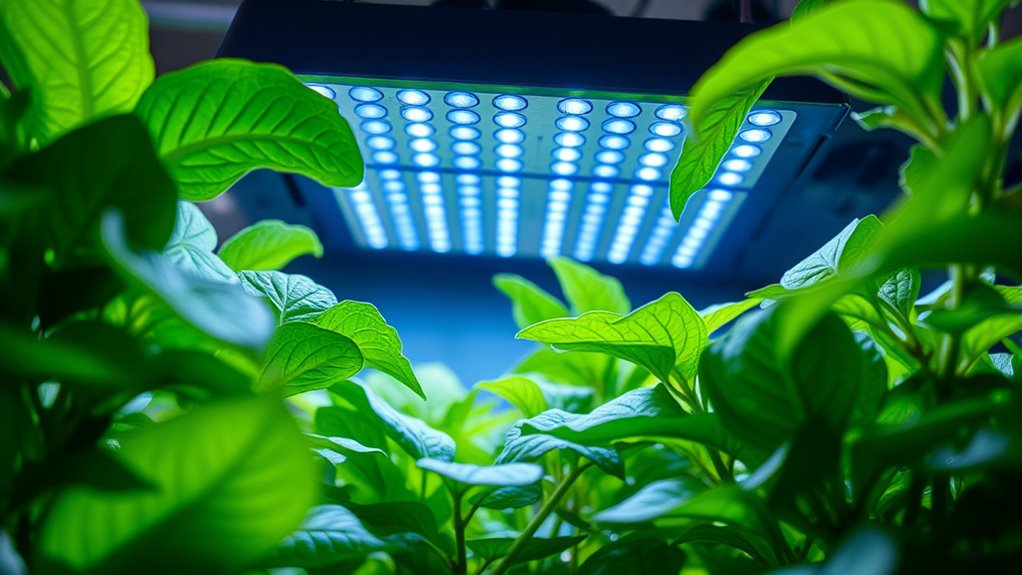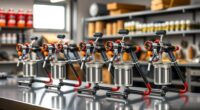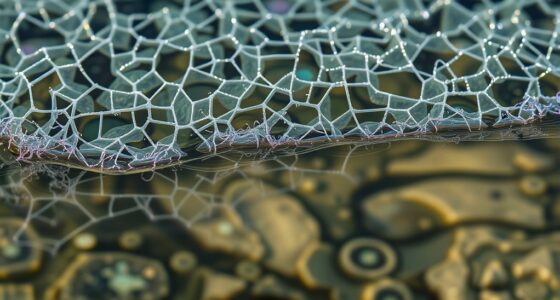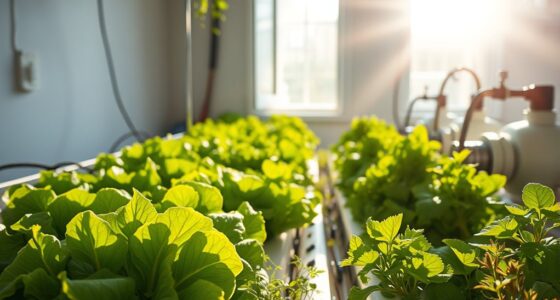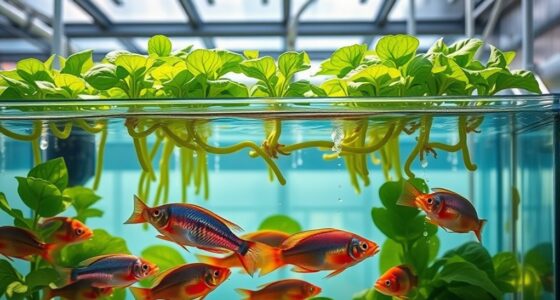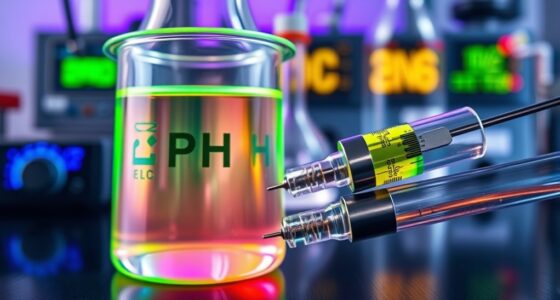To achieve ideal growth for leafy greens and herbs, aim for a PPFD of 150-300 µmol/m²/sec during the vegetative stage. Measure your light’s PPFD or use manufacturer specs at specific distances, then adjust your fixture height to reach your target. Remember, light intensity decreases as you move it further away. Understanding these principles helps you set up your space efficiently. Keep exploring to learn how to fine-tune your setup for the best results.
Key Takeaways
- Leafy greens and herbs typically need a PPFD of 150-300 µmol/m²/sec during vegetative growth.
- Adjust grow light height based on manufacturer PPFD specs to reach desired PPFD at plant canopy.
- Increasing the distance from the light decreases PPFD; decreasing the distance increases PPFD.
- Use PPFD measurements to ensure even coverage and prevent light stress or insufficient lighting.
- Continually monitor and fine-tune light height and placement for optimal plant health and growth.
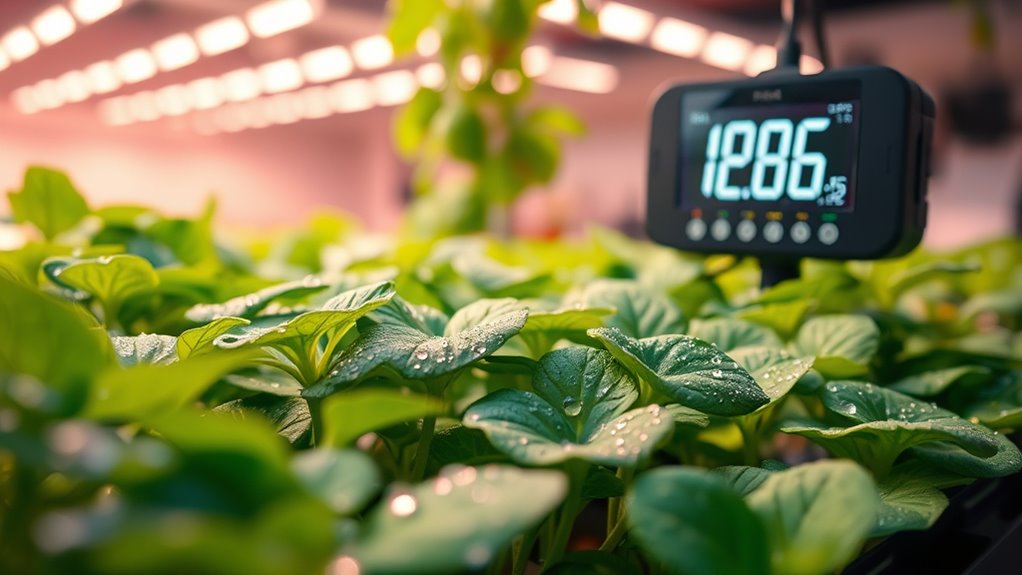
Understanding lighting math can seem challenging at first, but with a few simple principles, it becomes much easier. When you’re setting up grow lights for leafy greens and herbs, the key is to comprehend how much light your plants need to thrive. This measurement is called PPFD—photosynthetic photon flux density—which indicates how many micromoles of light hit a square meter each second. Knowing your target PPFD helps you deliver the right amount of light without wasting energy or stressing your plants. To figure out your PPFD needs, think about the type of plant and its growth stage. Leafy greens and herbs generally require between 150 and 300 micromoles per square meter per second during the vegetative stage. Once you understand this, you can start calculating the proper lighting setup.
The first step is understanding the relationship between light intensity, distance, and coverage area. Light intensity diminishes as you move the light farther from your plants, so placing your grow lights too high can lead to insufficient PPFD, while placing them too close risks light burn. To get an accurate measurement, you’ll need a PAR meter, which measures PPFD directly. If you don’t have one, you can estimate using manufacturer’s specifications for your grow light, which typically provide PPFD values at a certain distance. Additionally, understanding the GMC tuning principles can help optimize your grow light setup for maximum efficiency.
Once you know your target PPFD and the light’s PPFD output at a specific distance, you can determine the right hanging height of your fixture. For example, if your LED light provides 600 micromoles at 12 inches, and your target PPFD is 200, you can adjust the height accordingly. Moving the light closer increases PPFD, while moving it further decreases it. This allows you to fine-tune your setup for ideal plant growth.
To cover a certain area with the right PPFD, you also need to think about the light’s coverage footprint. Manufacturers usually specify how much area the light will effectively cover at a certain PPFD. If you’re growing in a small space, you might use a single fixture; for larger areas, multiple lights are necessary. Proper spacing ensures uniform light distribution, which prevents uneven growth or shaded spots.
Frequently Asked Questions
How Does PPFD Relate to Overall Plant Health?
PPFD directly impacts your plant health by providing the ideal amount of light for photosynthesis. When you guarantee your plants receive the right PPFD levels, they grow stronger, healthier, and produce better yields. Too little light stunts growth, while too much can cause stress or damage. By monitoring and adjusting PPFD, you give your plants the perfect light environment, promoting vigorous growth and overall well-being.
Can PPFD Targets Be Adjusted for Different Growth Stages?
Yes, you can adjust PPFD targets for different growth stages. When your plants are seedlings or young, lower PPFD levels prevent stress and promote healthy development. As they mature, gradually increase the PPFD to support robust growth and maximize yields. Monitoring your plants’ responses helps you fine-tune these adjustments, ensuring they get the right amount of light at each stage for ideal health and productivity.
What Are Common Mistakes When Calculating PPFD?
When calculating PPFD, you often make mistakes like misreading the light meter, forgetting to account for distance, or ignoring the light’s efficiency. You might also assume constant light output, but it can vary with bulb age or temperature. Always double-check measurements, guarantee proper distance, and use accurate conversion factors. These steps help you avoid common errors and get precise PPFD values for ideal plant growth.
How Does Light Spectrum Influence PPFD Requirements?
Ever wondered how the light spectrum impacts your PPFD needs? It’s essential because different wavelengths influence plant growth uniquely. Blue light boosts leafy green development, so you might need higher PPFD levels for ideal results. Red and far-red light affect flowering and stretching, altering your PPFD targets. Ignoring spectrum specifics can lead to under- or over-lighting, risking poor growth. Adjust your light spectrum thoughtfully to meet your plants’ precise needs and achieve thriving, healthy greens.
Is There a Recommended PPFD Range for Organic Leafy Greens?
Yes, there’s a recommended PPFD range for organic leafy greens, typically between 200 and 400 micromoles per square meter per second. You should aim for this range to promote healthy growth without stressing the plants. Adjust your lighting based on your plant’s development stage—seedlings need lower levels, while mature greens thrive at higher PPFD values. Monitoring and fine-tuning guarantee peak growth and yield.
Conclusion
Now that you understand PPFD targets for leafy greens and herbs, you’re better equipped to optimize your grow setup. Remember, a well-lit plant is a happy plant, and “a little effort goes a long way.” By applying these simple math principles, you’ll see healthier growth and better yields. Keep learning, stay consistent, and watch your garden thrive—because when you nurture your plants right, they’ll reward you in abundance.

